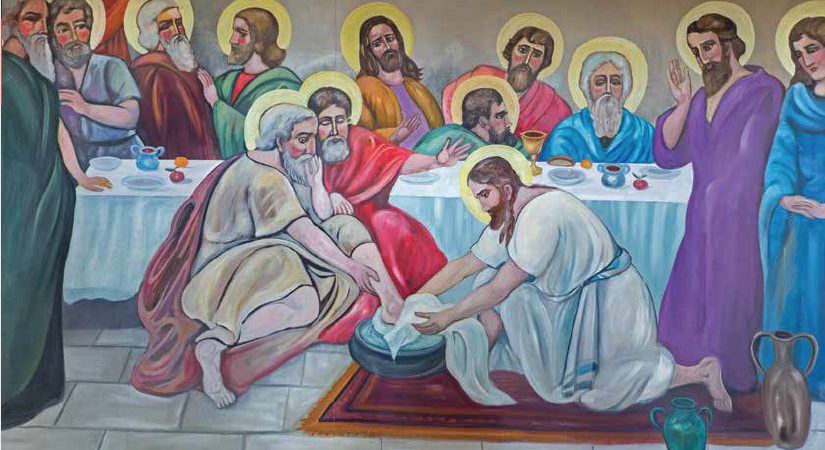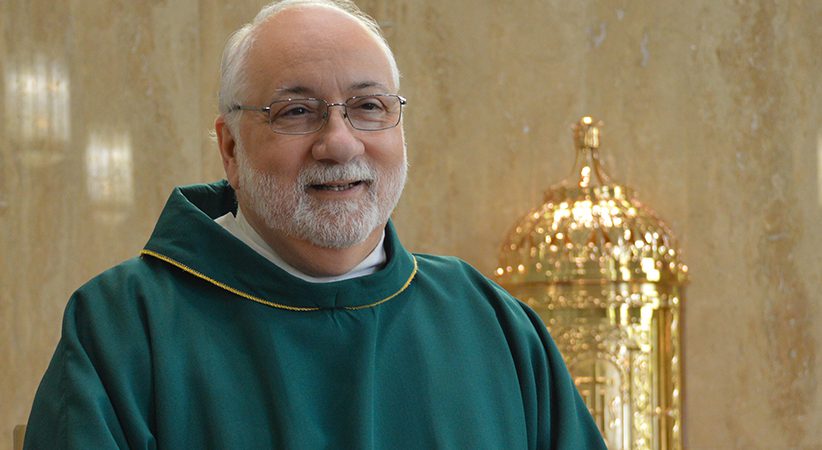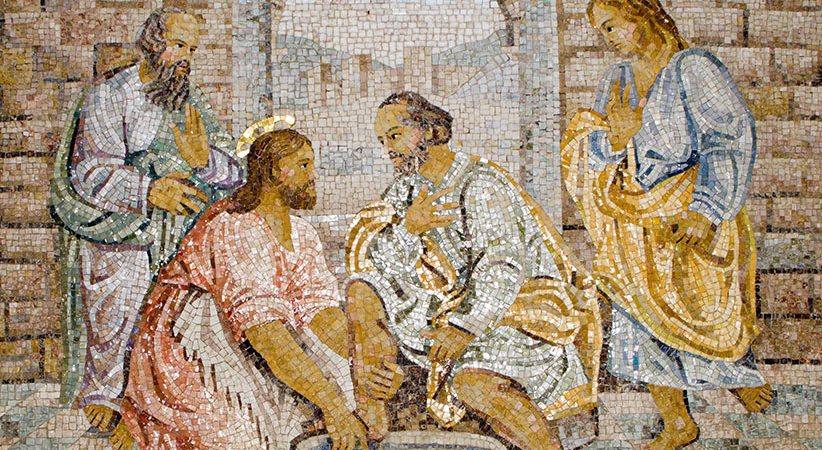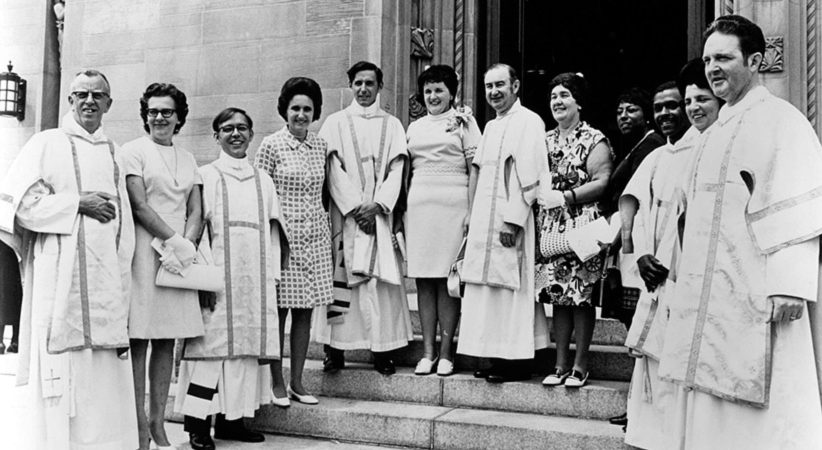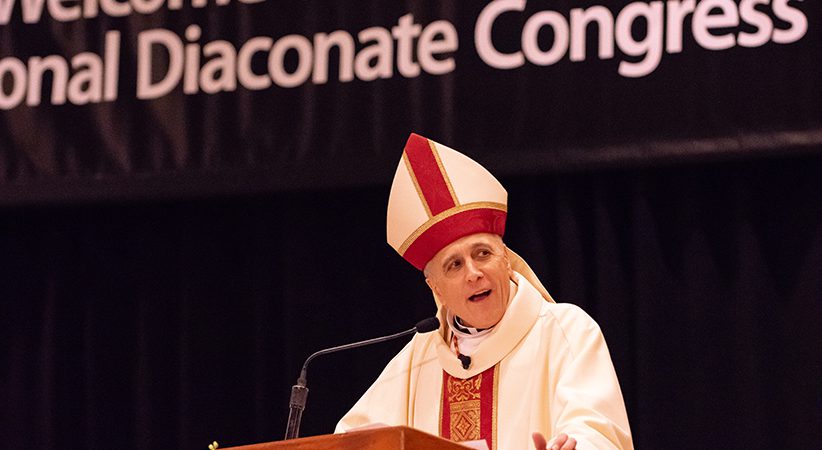A New Approach to the Origins of the Diaconate
The diaconate is an integral part of the mystery of salvation, complementing the episcopacy and priesthood
Deacon Dominic Cerrato Comments Off on A New Approach to the Origins of the Diaconate
Since its restoration some 50 years ago, the diaconate has struggled to find its voice in the wider Church. While the Tradition and magisterium have affirmed the place of the diaconate alongside bishops and priests within the Sacrament of Holy Orders, there’s little in the way of theology that unites these orders. In other words, if we take as a fundamental starting point the unity of holy orders as the Church does, then there ought to be a way in which each degree shares, each in its own measure, a common origin and mission.
Lacking this, the diaconate is seen as merely a supplementary add-on, with the deacon only functioning as father’s helper. Sadly, this is a common perception. However, if it can be theologically demonstrated that the diaconate is an integral part of the mystery of salvation complementing the episcopacy and priesthood, then the diaconate can be seen as having a unique and indispensable contribution to the life and mission of the Church. This is not to raise the diaconate to more than it is, but instead to recover God’s original intent and thus fulfill the Church’s mission more effectively.
Some years ago, I quite providentially stumbled upon the unity of holy orders while exploring the origins of the diaconate in my book, “In the Person of Christ the Servant” (St. Ephraem Press, $19.95). Using the personalist thought of Pope St. John Paul II, I now possessed the philosophical language to better explain diaconal ministry as not so much something we do but rather someone we give — our very selves. This gift-of-self, which is simply another way of speaking about love, intrigued me, especially as it played out in the Paschal Mystery. It was there that I discovered what I would later call “the Establishment Hypothesis.”
Three Fundamental Principles
The Establishment Hypothesis is grounded on three fundamental principles. First, and most important, the Paschal Mystery — this is to say, Christ’s passion, death and resurrection — is the source of our salvation (rf. Catechism of the Catholic Church, No. 571). Second, this salvation is offered by God, through his Church, by way of holy orders (CCC, No. 1536). Third, just as the Paschal Mystery was nothing less than a divine gift-of-self, so, too, it’s perpetuated through a similar gift-of-self in the three-degrees of holy orders. In this respect, as good disciples, bishops, priests and deacons follow Christ’s example by their own gift-of-self, their own acts of love (cf. Mt 10:38, Mt 16:24, Mk 8:34, Lk 9:23, Lk 14:27).
In many respects, the Last Supper is not only part of the Paschal Mystery, it encapsulates it. In terms of the priesthood, the Church has long looked to this event as its institution, along with the episcopacy, which is the fullness of orders. If there is a cohesive unity to be found in holy orders, then it would make sense to find it in the Paschal Mystery and, because this mystery is encapsulated in the Last Supper, the Last Supper should be our starting point.
………………………………………………………………………………………………………………………………………………………….
Reconciling Act’s 6 with the Establishment Hypothesis
Given the unanimous witness of the tradition, the question arises: How can we reconcile the institution of the Seven with the Establishment Hypothesis? One way to address this apparent conflict is through the distinction between officium (office) and ordo (order). An office is a position in a larger organization that carries with it a specific function, and order is an office shared by two or more forming a recognized body. In the order of causality, an office always precedes an order.
Where the mandatum established the office of deacon, the selection of the Seven and laying on of hands in Acts 6 represents the institution of the order. Where the office represents a kind of conception, the order represents a kind of birth.
There is some implicit evidence for this process in the Scriptures. We know, for example, that the office of priesthood was established at the Last Supper. However, the presbyterate order was instituted sometime after as witnessed by Timothy. Likewise, we can say that the episcopate office (the fullness of orders) was also established at the Last Supper. However, the episcopal order was instituted sometime after as again witnessed by Timothy. If this is true of the presbyterate and episcopate, then it’s reasonable to conclude that it’s also true of the diaconate.
………………………………………………………………………………………………………………………………………………………….
On the night before he died, Jesus shared the Passover meal with the Twelve. There he issued two distinct sets of commands. The first is found in the synoptic Gospels and consist of: “Take and eat … Take and drink … Do this in memory of Me …” (Mt 26:17-30, Mk 14:12-26, Lk 22:7-39).
These are known as the institutional narratives as they institute both the Eucharist and the priesthood. However, during that same meal there was another command, not found in the synoptics, but instead in John’s Gospel. There, Jesus, after washing the feet of his disciples said, “I have given you a model to follow, so that as I have done for you, you should also do (Jn 13:15).”
This is known as the mandatum. On Holy Thursday, the Ceremonial of Bishops calls for the bishop to begin the foot washing by removing his chasuble, under which is the dalmatic. Pope Francis, during the same ritual, refashions his priestly stole into a diaconal stole before washing the feet of the people. They do this because while they are bishops, they still possess the diaconate, and there is something intuitively diaconal about this act.
In this one event, an event that encapsulates the Paschal Mystery, we have two dominical commands, one unmistakably priestly in nature and the other unmistakably diaconal. In this respect, the Establishment Hypothesis is not really new.
Deacon James Keating writes: “The foot-washing scene at the Last Supper is an expression of the institution of the diaconate by Christ, since it reflects the doctrinal truth of the unity of holy orders. There is symmetry between the ‘Do this in memory of me’ (Lk 22:19) charge to the apostles and his other apostolic charge, ‘So that as I have done for you, you should also do’ (Jn 13:14-15).” In making this claim, Deacon Keating cites Cardinal Walter Kasper, who in a paper asserts:
“We have seen that without diaconia there cannot be a Church, because Christ himself is one who serves (Lk 22:27). Therefore, at the Last Supper … he not only established the idea of priesthood, but, in principle, also laid the foundation of the diaconal ministry. By the washing of feet he gave us an example, so that we also do, as he did to us (Jn 13:15). In these words one can see the foundation of the diaconate.”
Acts of Love
Where the Establishment Hypothesis breaks new ground, and where it moves beyond Keating and Kasper’s intuitive observation, is that it describes precisely how this happens through a series of successive gifts (acts of love). Critical to this is the fundamental reality that we simply can’t give what we don’t possess. In other words, if the apostles didn’t receive the fullness of what we now call holy orders from Christ, they couldn’t pass it on to the bishops. Likewise, if the bishops didn’t receive holy orders from the apostles, they couldn’t pass it on to priests and deacons. In a similar fashion, if priests and deacons didn’t receive their orders from the bishops, they couldn’t pass it on to the laity in the form of priestly and diaconal ministry.
The Gift-of-Self
To better appreciate what I mean about the gift-of-self, I’ll break this process down into seven simple steps that refer to the diagram.
• Step 1: Through his gift-of-self on the cross, Jesus reconciles humanity to the Father, and this offer of reconciliation is encapsulated in the Last Supper.
• Step 2: In the Last Supper, Jesus issues two commands to his apostles, one priestly and the other diaconal.
• Step 3: These commands, in light of the Paschal Mystery, establish both the priesthood and the diaconate.
• Step 4: The apostles, having received this gift-of-self from Christ in the form of the priesthood and diaconate, now gift themselves to their successors, the bishops (cf. Lumen Gentium, No. 20).
• Step 5: The bishops, having received this gift-of-self from the apostles in the form of the priesthood and diaconate, now gift themselves to priest and deacons through the conferral of holy orders.
• Step 6: The priests and deacons, having received this gift-of-self from the bishop in the form of the priesthood and diaconate, now reveal in a distinctive and complementary manner the whole Christ (Christus totus). As a result, they gift themselves to the laity through evangelizing and the sacraments.
• Step 7: The laity, having received this gift-of-self from priests and deacons, now gift themselves in the living out of their vocations.
Christ’s total gift-of-self means that the complementary relationship between the episcopacy, priesthood and diaconate find their nexus in the one person of Christ. Each order participates and contributes in a unique way bringing the Christus totus to the world. This means that, through the use of Pope St. John Paul II’s personalist language, we have, for the first time, not only a new way of envisioning the origins of the diaconate, but, perhaps even more important, an organic way of speaking about the unity of holy orders.
If the above is true, and I believe it is, then the diaconate isn’t ancillary to God’s plan of salvation, but an absolute integral and indispensable component born in the mind of the Father before all ages. It’s for this same reason that the diaconate needs to rediscover its own voice, entering more fully into the Catholic imagination not simply for its own sake, but for the sake of those we serve, for the sake of redemption, for the sake of a divine love outpoured.
DEACON DOMINIC CERRATO , Ph.D., is editor of Deacon Digest and the director of diaconal formation for the Diocese of Joliet, Illinois. He is founder of Diaconal Ministries, where he gives national presentations and retreats to deacons and diaconal candidates.


